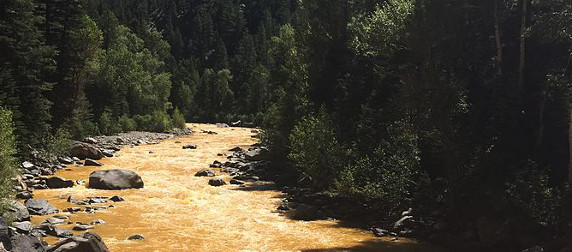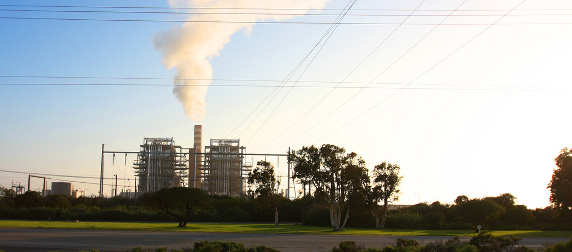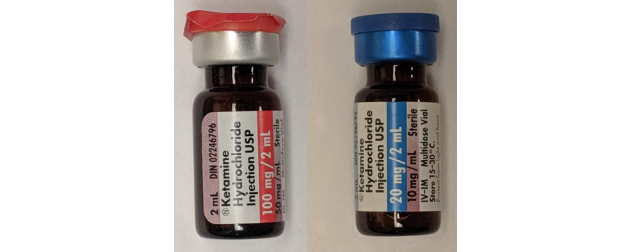
The Animas River between Silverton and Durango in Colorado, USA, within 24 hours of the 2015 Gold King Mine waste water spill. Photo by Riverhugger via Wikimedia Commons.
Not long ago, the Environmental Protection Agency made a mistake.
In early August, the EPA was working to clear toxic metals from an abandoned mine in Colorado when it accidentally released 3 million gallons of polluted water. The toxic sludge reached New Mexico within a few days and eventually entered Lake Powell, an aquatic playground that draws 2 million visitors annually and which is also the nation’s second-largest reservoir, providing water for human and agricultural use across much of the Southwest.
Of course, the EPA never meant for this to happen. It was trying to protect Colorado’s water supply from contamination with heavy metals when its workers inadvertently triggered the spill.
The agency was nevertheless criticized for not notifying residents of the breach quickly enough and for not taking sufficient precautions to prevent the incident in the first place. A series of hearings began last week in an attempt to shine further light on the incident.
The EPA itself has taken responsibility and discussed improving procedures for future cleanup efforts. The agency’s inspector general announced an investigation into the causes of the spill and the subsequent response, at Congress’ request. And EPA Administrator Gina McCarthy has said the agency will conduct internal reviews and hire a third party agency for an independent review. More recently, the EPA suspended cleanup operations at 10 mining sites, across several states, due to similarities to the conditions that caused the Colorado spill.
The internal and external investigations are appropriate, and so is the EPA’s acceptance of responsibility. What we haven’t heard, however, is any indication of official interest in holding any individual accountable. There has been no call for prosecutions, fines or even for somebody to lose his or her job.
Contrast the response when government officials screw up with the aftermath of similar accidents in private industry. Exhibit A is, of course, the 2010 BP oil spill in the Gulf of Mexico. Amid initial outrage and calls for BP to take responsibility for the disaster, President Obama extracted $20 billion from the company with no specific finding of the extent of the damage. More than five years later, BP settlement payments are still flowing, though the oil has long since stopped.
Probably a more directly comparable situation, however, was the 2014 Elk River chemical leak in West Virginia. A chemical used to wash coal spilled into the Elk River, which is a major source of drinking water for several counties. As a result, drinking water supplies were shut down until they were deemed safe, a little over a month later.
Scarcely a week after the spill, the company responsible, Freedom Industries, filed for Chapter 11 bankruptcy. By that time, Freedom already faced 25 lawsuits connected to the incident, including federal complaints. Two of the company’s former owners, William Tis and Charles Herzing, pleaded guilty earlier this year to environmental violations stemming from the accident. Federal prosecutors have said that Freedom knew about critical flaws at its Charleston plant but ignored them, and that tank conditions “put an entire population needlessly at risk.” The president of Freedom Industries at the time of the spill, Gary Southern, also faces criminal charges linked to allegedly deceptive attempts to deflect blame for the accident from himself and to protect his personal assets.
Accidents happen. Some accidents are the result of gross negligence or of the violations of underlying law, such that they warrant punishment. But a lot of other accidents are simply low-probability events that happen because humans are not perfect. Sometimes a chain of events leads to something going terribly wrong; not every such chain of events begins with an act that deserves prosecution or heavy fines.
Yet in the government’s view, the underlying causes of an accident are evidently less important than the identity - or rather, the employer - of the person making the mistake. While the Colorado spill certainly isn’t being ignored, it has not raised the sort of cry for restitution, or scapegoats, that similar accidents triggered when employees of private sector companies caused them. It is hard not to imagine that if someone other than the EPA had been responsible for the Colorado spill, the congressional hearings would have been accompanied by aggressive prosecutions and fines, not simply politicians’ mild disapproval.
The government clearly understands that sometimes accidents just happen - at least when they are clearly and solely the government’s fault. Otherwise, what officials often deliver amounts to nothing more than publicity-seeking Monday-morning quarterbacking coupled with an invasive cash-ectomy.














September 20, 2015 - 3:22 pm
The good news related to the Gold King Mine spill is that no one was injured and it is doubtful that any additional lasting environmental damage was done.
My understanding of the situation follows.
The EPA was trying to prevent exactly what happened with obviously a very limited budget.
The way I understand the situation is that a cave in had blocked the flow of water from the mine. The EPA saw the risk of the cave in debris giving way and releasing the backed up water and precipitate all at once and they were taking action to prevent exactly what happened..
They built retention ponds down the hill with the intent of releasing the water gradually into the retention ponds. The pH of the water was reported as pH 3.46, acidic. They would therefore use Calcium Carbonate (lime) to raise the pH to precipitate the maximum of metal ions, allow the precipitates to settle to the bottom and decant the clarified water into the river. Over time they would thus clean up the accumulated contaminates.
The same amount of contaminates would have reached the river over time if there had been no cave in to restrict the flow of water from the mine.
The mustard colored precipitate in the spill that attracted so much attention is called yellow boy by miners and is a compound of trivalent iron similar to a compound used by municipalities to remove contaminates from drinking water.
The EPA evidently was unable to determine the height of the water inside the cavity of the mine and it was reported that the first swipe of the backhoe on the ceiling of the mine that started releasing water so they ran from the area. The rush of water evidently washed away the debris holding back the water.
All of the contaminates and “toxins” reportedly in the spill are always present in the river water and the municipalities that use that water probably treat the water with trivalent iron followed by introducing some poison, chlorine or chloramine, to kill bacteria and parasites before distributing it as drinking water.
Why would you punish a person that had to expose themselves to all of these toxins described in the press repeatedly to develop and carry out the project in an effort to prevent others from being exposed. It was an accident that in the end did not harm anyone.